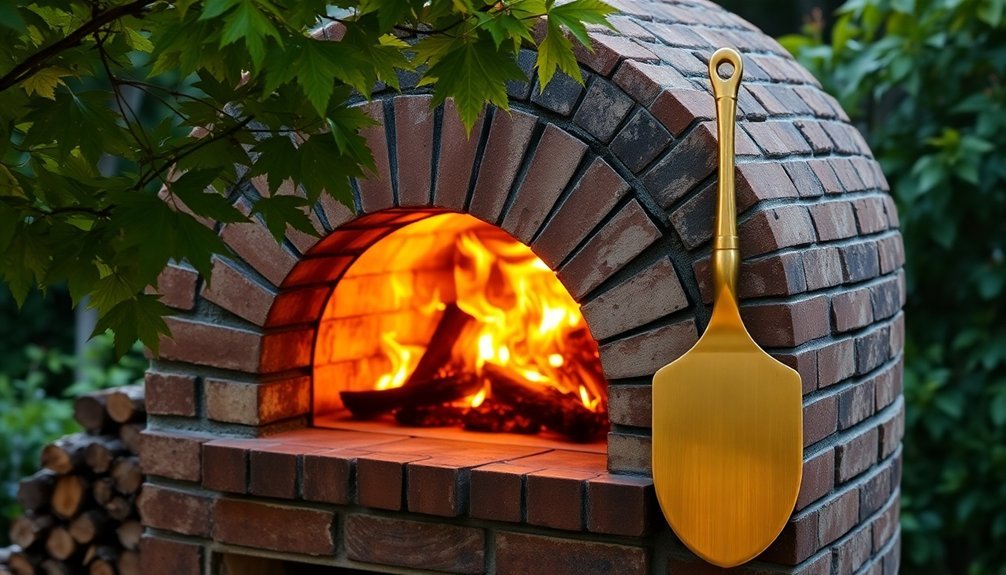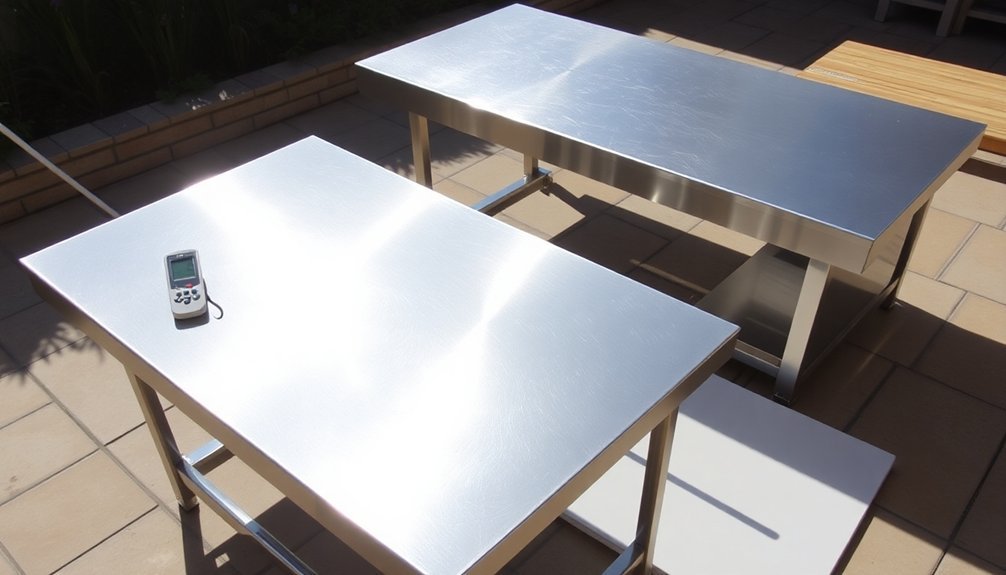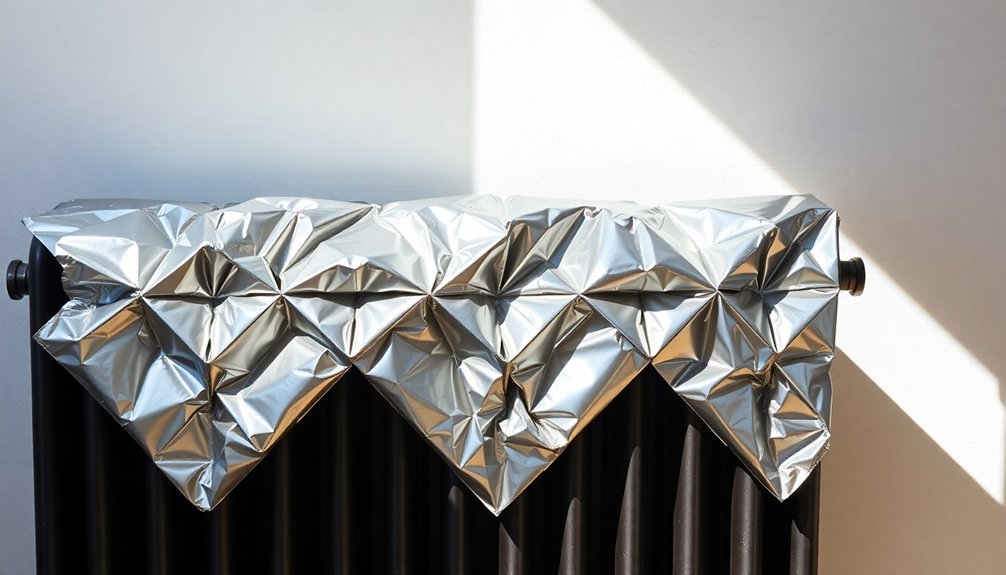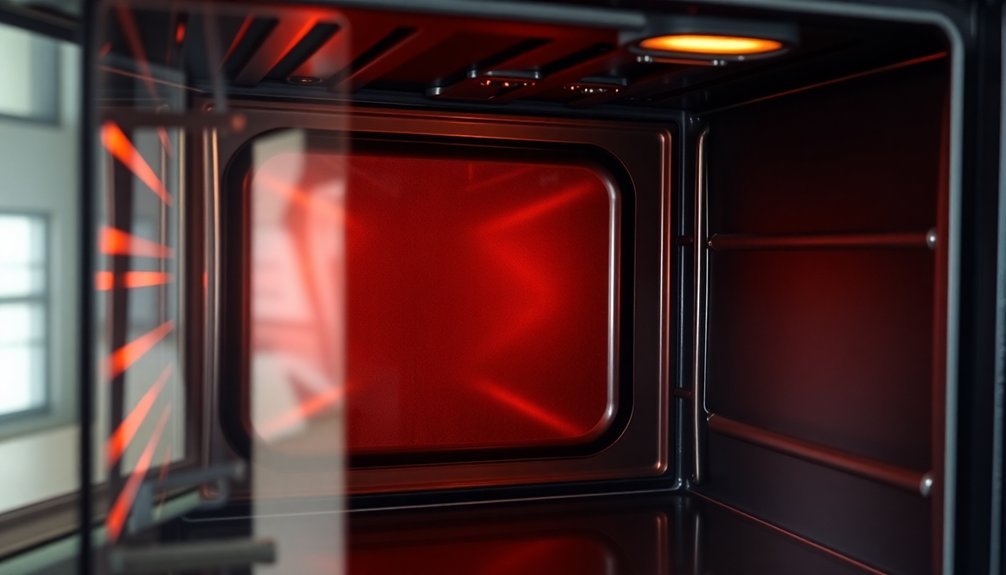To keep your outdoor oven hot while cooking, start with well-seasoned hardwoods like oak, hickory, or maple that have dried for at least 12 months. Position your firewood strategically with larger logs at the back and smaller pieces in front, ensuring proper airflow between them. Monitor temperatures using gauges near the cooking surface and dome area, adjusting dampers to control oxygen flow. You'll want to preheat for 30 minutes minimum and maintain temperatures between 500-700°F for ideal results. Rotate food regularly and use a pizza stone to distribute heat evenly. Master these fundamentals, and you'll release the full potential of your outdoor oven.
Best Wood Selection for Heat

When selecting wood for your outdoor pizza oven, hardwoods are your best choice for maintaining consistent high temperatures. Oak, hickory, cherry, maple, and ash deliver superior heat output due to their density, ensuring your oven stays hot throughout the cooking process.
You'll want to avoid softwoods like cedar and pine, as they burn too quickly and don't generate enough heat for proper pizza cooking. While they're cheaper and easier to find, they're best used only as kindling to start your fire. These materials produce low sap content, making them cleaner-burning options compared to resinous woods.
Instead, choose well-seasoned hardwood that's been dried for at least 12 months, with pieces cut to 2-3 inches square and 18-24 inches long. For ideal results, you can mix different hardwoods to achieve the perfect balance of heat and performance.
Temperature Monitoring Tools
You'll need to position temperature gauges strategically in your outdoor oven, with one near the cooking surface and another in the dome area to monitor heat distribution.
For accurate spot measurements, hold your infrared thermometer perpendicular to the surface you're measuring, and take readings from multiple locations to build a complete temperature profile. Implementing real-time temperature tracking allows you to make immediate adjustments to maintain optimal cooking conditions.
When using an infrared thermometer, keep the lens clean and maintain a consistent distance from the surface to guarantee reliable readings across different areas of your oven.
Essential Temperature Gauge Placement
Proper temperature gauge placement stands as the cornerstone of successful outdoor oven cooking.
You'll need to position thermocouples at key locations, including the hearth floor and within the oven structure, to monitor temperatures effectively. Four to five thermocouples are typically recommended for comprehensive temperature monitoring across the oven. Install these wires during construction by laying them between the firebrick and ceramic fiber blanket for protection.
When mounting dome thermometers, make sure you're using probes that extend at least 25 cm through the wall and insulation.
You can opt for Bluetooth-enabled models to track temperatures remotely through your phone. While stationary gauges work well for consistent tasks like bread baking, you'll find portable laser thermometers more versatile for mapping hot spots.
Don't forget to seal door thermometers with red silicone to prevent heat loss and maintain accurate readings throughout your cooking sessions.
Infrared Thermometer Best Practices
An infrared thermometer revolutionizes outdoor oven temperature monitoring with its precise, non-contact measurements. For ideal accuracy, place a pizza stone or cast-iron skillet in your oven while it heats up, then apply a light coat of cooking oil to enhance temperature reading accuracy.
To get the most reliable readings from your infrared thermometer:
- Point the device directly at the oiled cooking surface, not the surrounding walls or floor.
- Hold steady at eye level and maintain the trigger until the reading stabilizes.
- Avoid measuring through glass or transparent surfaces that can distort readings.
- Take consistent measurements from the same spot for reliable temperature tracking.
For best results, verify your thermometer is properly calibrated and consider using a Bluetooth-enabled model for real-time monitoring and alerts.
Air Flow Management

Your oven's vent position plays an essential role in maintaining ideal heat levels and directing smoke flow.
You'll want your stovepipe to draw smoke efficiently away from the oven chamber while following the "3-2-10 Rule" for proper chimney height.
To control airflow effectively, consider factors like elevation, wind patterns, and nearby obstructions that can impact your oven's natural draw.
Vent Position Affects Heat
Strategic vent positioning directly controls how heat moves through your outdoor oven.
You'll find that proper placement guarantees ideal air circulation while maintaining consistent cooking temperatures. By managing both top and bottom vents, you're creating a natural convection flow that distributes heat evenly throughout the cooking chamber.
- Lower vents supply fresh air to fuel combustion and should be positioned near the fire source.
- Upper vents release hot air and smoke, creating a chimney effect that pulls fresh air through.
- Side vents can help manage temperature zones and prevent hot spots.
- Door vents allow precise temperature control during low-and-slow cooking sessions.
Remember that your vent adjustments should account for external factors like wind and humidity.
Opening both vents increases air flow and temperature, while partially closing them helps maintain lower temperatures for slow cooking.
Draft Control Basics
Beyond vent positioning, mastering draft control fundamentals will elevate your outdoor oven's performance.
Your draft door serves multiple essential functions: it seals the chamber, directs smoke upward, and reflects heat back into the cooking space.
You'll need to adjust your draft controls based on both cooking needs and weather conditions. When you need more heat, open the drafts to increase oxygen flow. To reduce temperature, close them partially to restrict airflow.
Remember, you're looking for balance – too much air creates hot spots, while too little stifles your fire.
Watch how weather affects your oven's behavior. Cooler temperatures enhance chimney draft, while warm weather reduces it.
You'll find that wind conditions may require draft door adjustments to maintain stable cooking temperatures and proper smoke flow.
Strategic Wood Placement
Mastering wood placement in your outdoor oven can make the difference between mediocre and exceptional cooking results. Position your fire between the back and side of the oven to create versatile heat zones while maximizing your cooking space.
You'll want to split hardwoods like oak or hickory into smaller pieces for efficient burning.
Keep your cooking session hot and consistent by following these proven strategies:
- Preheat fresh wood on the opposite side of your oven before adding it to the fire.
- Create a horseshoe-shaped fire layout for larger ovens when you need extensive heat coverage.
- Use an andiron to push embers under your cooking area while keeping new wood on top.
- Position softwoods like pine near the entrance for quick kindling when needed.
Heat Distribution Techniques

To master your outdoor oven's performance, you'll need to create distinct heat zones by strategically positioning embers and managing hotspots through proper dome-shaped heat circulation.
You can control the airflow by adjusting your oven's door position and utilizing the dome's natural convection properties to direct heat where it's needed most.
The key to maintaining consistent temperatures lies in understanding how heat moves within your oven's chamber, allowing you to establish different cooking zones for various dishes and temperatures.
Creating Heat Zones
Successful outdoor oven cooking depends on creating distinct heat zones that let you control temperature and cooking methods.
You'll want to strategically place coals both under and on top of your camp oven to achieve even heat distribution.
When managing these zones, use a lid lifter to check your food without losing precious heat, especially while baking.
- Preheat your oven for 10-15 minutes before adding ingredients
- Place more coals on one side to create a hot zone for searing
- Keep fewer coals on the opposite side for slower cooking
- Adjust coal placement throughout cooking to maintain desired temperatures
Managing Hotspots Effectively
Smart outdoor cooking hinges on your ability to manage hot spots effectively. You'll find these intense heat zones typically around your oven's periphery – the sides, bottom, and top.
To combat uneven cooking, use baking stones to diffuse heat and rotate your food regularly during the cooking process.
Position your cookware strategically by placing pans in the middle rack for consistent results. When using multiple racks, swap positions from front to back and top to bottom halfway through cooking.
For roasts, place the thicker end near hot zones to prevent the thinner sections from overcooking.
Don't forget to keep the oven door closed to maintain steady temperatures, and use thicker cookware to distribute heat more evenly.
Consider using foil liners to help with both heat distribution and cleanup.
Airflow Control Methods
While mastering an outdoor oven requires skill, proper airflow control stands as the cornerstone of heat distribution.
You'll need to understand how ventilation affects your cooking temperature and performance. Whether you're using a traditional front vent or center vent design, managing airflow is vital for maintaining consistent heat.
To optimize your oven's airflow:
- Adjust the door opening to regulate oxygen flow – wider for higher temperatures, narrower for heat retention
- Position your vent dampers strategically to pull hot air across the dome, ensuring even distribution
- Monitor the smoke flow pattern to gauge if you're achieving proper circulation
- Use the door as a control mechanism, closing it completely when you need to trap heat
Insulation Maintenance Tips
To maximize your outdoor oven's performance and longevity, proper insulation maintenance is essential throughout the year. Inspect your oven's insulation at least annually, or more often if you're a frequent user.
Check for hairline cracks and seal them immediately to prevent water infiltration that can compromise the insulation layers.
You'll need to dry out and weatherproof your oven each year to maintain its protective barriers.
When using your oven, always avoid thermal shock by heating and cooling it gradually. Add wood in small amounts to build temperature slowly, and use your door or damper to control the cooling process.
If you notice any damage to the ceramic fiber blanket or vermiculite layer, repair it promptly to maintain ideal heat retention and fuel efficiency.
Weather Impact on Oven Performance

Outdoor ovens face constant challenges from Mother Nature's elements, making weather awareness a key part of successful operation.
You'll need to adapt your cooking approach based on weather conditions to maintain peak performance and protect your investment.
To manage weather impacts effectively:
- Monitor forecasts and cover your oven when rain or snow is expected to keep fuel dry and prevent water absorption.
- Shield your oven from high winds using strategic positioning or barriers to maintain consistent heat levels.
- Adjust cooking times during high humidity, as moisture affects how quickly food cooks and can lead to overcooking.
- Install proper insulation and use heat-retaining materials to combat temperature extremes.
Door Management While Cooking
Managing your outdoor oven's door properly can make or break your cooking success. During the initial heating phase, keep the door off completely to maximize air circulation and oxygen flow to your fire.
Once you're ready to cook, adjust the door position based on your cooking method. For cooking with active fire or embers, leave the door slightly ajar to maintain proper ventilation and prevent unwanted fume buildup.
When smoking foods, position the door to allow smoke to gently pass over your dishes without lingering. During grilling, a loosely closed door can intensify the heat beneath your food.
For baking, braising, or slow cooking with no active embers, close the door tightly to retain heat and guarantee even temperature distribution.
You'll want to minimize door openings to maintain consistent heat levels.
Ash and Debris Control

Proper ash and debris control plays an essential role in maintaining your outdoor oven's performance and longevity.
You'll need to wait until your oven's completely cool before starting the cleaning process. Using a copper or brass brush, sweep ash and debris toward the oven opening, collecting it in a covered metal container.
For ideal maintenance and safety, follow these key steps:
- Remove cold ashes before starting a new fire to guarantee proper heat distribution.
- Never use steel BBQ brushes or natural fiber brushes, as they can damage your oven floor.
- Don't use soap or solvents inside the oven – most food spills will burn off naturally.
- Store collected ashes in a sealed metal container on a non-combustible surface.
If you're dealing with stubborn baked-on debris, use your copper brush to scrape it away, and consider using white vinegar for gas ovens.
Temperature Recovery Methods
When temperatures drop in your outdoor oven, effective recovery methods can quickly restore ideal cooking conditions.
Start by placing a baking stone or pizza stone inside, as these tools excel at absorbing and releasing heat steadily. They'll help minimize temperature fluctuations and reduce recovery time when you need to open the door.
Keep your oven door closed as much as possible since each opening can drop the temperature by up to 50°F.
If you're using a wood-fired oven, adjust your fire placement to create prime heat zones and maintain a steady ember base.
You'll want to verify your ceramic fiber insulation is working effectively to trap heat inside.
For consistent cooking temperatures, consider placing multiple stones or ceramic tiles throughout your oven, creating additional thermal mass that stabilizes the overall temperature.
Preheating Time Requirements

Different outdoor oven types require varying preheating times to reach ideal cooking temperatures.
You'll find that gas ovens heat up relatively quickly, taking just 15-30 minutes, while wood-fired ovens need 40-60 minutes to achieve the best results.
For consistent performance across different oven types, follow these essential preheating guidelines:
- Heat gas ovens for at least 30 minutes, even if they claim faster preheating capabilities.
- Allow wood-fired ovens a full hour to reach and maintain their 400°C cooking temperature.
- Preheat tabletop ovens like Ooni for 30 minutes, despite their ability to reach higher temperatures.
- Use a laser thermometer to verify your pizza stone's temperature before starting to cook.
Remember that proper insulation, especially with ceramic fiber materials, helps maintain consistent temperatures throughout your cooking session.
Heat Zone Optimization
Understanding your outdoor oven's heat zones proves essential for achieving perfectly cooked pizzas every time.
You'll need to master three key zones: the high-heat zone near the heat source reaching 900°F for crisping crusts, the medium-heat zone at 500-600°F for even cooking of toppings, and the low-heat zone around 450°F for gentler cooking near the entrance.
To optimize these zones, you'll want to maintain a floor temperature of 650°F and a dome temperature of 1000°F.
Use an infrared thermometer to monitor these areas precisely. Don't forget to rotate your pizzas between zones during cooking for even results.
If you're using a wood-fired oven, position your kiln-dried firewood strategically and adjust the dampers to control airflow and heat distribution effectively.
Frequently Asked Questions
How Long Can Pizza Dough Safely Sit at Room Temperature While Cooking?
You can safely keep pizza dough at room temperature for up to 4 hours while you're cooking. If you're using less yeast or cold water, you'll extend this time without risking over-proofing.
Can I Cook Different Types of Food Simultaneously in Different Oven Zones?
Yes, you can cook different foods simultaneously in the dual zones. You'll have independent temperature control for each side, letting you roast meat in one zone while cooking pizza or sides in the other.
What Emergency Steps Should I Take if the Oven Temperature Drops Suddenly?
If your oven temperature drops suddenly, add dry hardwood logs immediately, move your food to the hottest spots, and adjust cooking times. You'll want to keep white-hot embers spread across the cooking floor.
Should I Rotate the Position of Food Items During Extended Cooking Sessions?
Yes, you'll need to rotate your food items regularly during extended cooking sessions. It prevents burning, guarantees even cooking, and helps maintain consistent heat distribution throughout your cooking space for best results.
How Do Seasonal Changes Affect the Amount of Fuel Needed for Cooking?
You'll need more fuel in winter, using about three times as much as summer. Cold temperatures increase consumption to around 63 kg/day versus 18.5 kg/day in summer for maintaining cooking temperatures.
In Summary
You'll find maintaining consistent heat in your outdoor oven isn't complex once you've mastered these essential techniques. Remember to select dense hardwoods, monitor temperatures regularly, manage airflow effectively, and position your wood strategically. Keep your cooking zones optimized by clearing ash promptly and following proper preheating protocols. With these practices, you'll enjoy reliable heat throughout your outdoor cooking sessions.





Leave a Reply